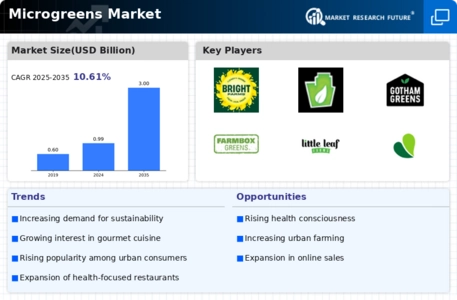Top Industry Leaders in the Microgreens Market
 The microgreens market has witnessed substantial growth in recent years, driven by increasing consumer awareness of their nutritional benefits and versatile culinary applications. As the market continues to expand, a thorough examination of the competitive landscape becomes essential. This analysis will delve into key players, strategies adopted, factors influencing market share, new entrants, industry news, investment trends, overall competitiveness, and notable developments in 2023.
The microgreens market has witnessed substantial growth in recent years, driven by increasing consumer awareness of their nutritional benefits and versatile culinary applications. As the market continues to expand, a thorough examination of the competitive landscape becomes essential. This analysis will delve into key players, strategies adopted, factors influencing market share, new entrants, industry news, investment trends, overall competitiveness, and notable developments in 2023.
Key Players:
- AeroFarms
- Fresh Origins
- Gotham Greens
- Madar Farms
- 2BFresh
- The Chef's Garden Inc.
- Farmbox Greens LLC
- Living Earth Farm, among others
Strategies Adopted:
To maintain and enhance their competitive positions, key players in the microgreens market have implemented various strategies. Product innovation stands out as a core approach, with companies introducing new microgreen varieties and blends to cater to diverse consumer preferences. Additionally, strategic partnerships with retailers and restaurants have enabled these players to expand their market reach and secure consistent demand for their products. Furthermore, investment in sustainable farming practices and technology adoption has been pivotal in ensuring a year-round supply of high-quality microgreens.
Factors for Market Share Analysis:
Market share analysis in the microgreens sector hinges on several critical factors. The ability to consistently deliver fresh, high-quality microgreens is paramount, influencing consumer loyalty and repeat business. Efficient supply chain management, including streamlined distribution channels and effective logistics, plays a crucial role in maintaining market share. Pricing strategies, aligned with the perceived value of the microgreens, also contribute significantly, as consumers increasingly seek affordable yet premium-quality produce.
New and Emerging Companies:
While established players dominate the microgreens market, new and emerging companies have entered the arena, adding dynamism and fostering healthy competition. Companies like Urban Produce, Living Cube, and FreshBox Farms are gaining traction with innovative growing techniques and sustainable practices. Although these entrants face challenges in establishing their market presence, their nimbleness and commitment to cutting-edge cultivation methods contribute to the evolving landscape.
Industry News and Current Companies:
Recent industry developments have highlighted the dynamic nature of the microgreens market. Gotham Greens, a key player, announced an expansion initiative to meet the growing demand for their products. This expansion includes the establishment of new greenhouse facilities, reflecting the company's commitment to scaling operations to match market requirements.
Simultaneously, BrightFarms, Inc. unveiled a strategic collaboration with a major supermarket chain to integrate its microgreens into the retailer's fresh produce section. Such partnerships not only enhance market visibility but also provide a competitive edge by securing prime shelf space in retail outlets.
Investment Trends:
Investment trends in the microgreens market reflect the industry's potential for sustained growth. Venture capital and private equity firms are increasingly investing in companies focused on vertical farming, hydroponics, and other innovative cultivation methods for microgreens. This influx of capital is crucial for research and development, infrastructure expansion, and technology adoption, ultimately supporting the sector's overall competitiveness.
Overall Competitive Scenario:
The microgreens market's overall competitive scenario is marked by a balance between established players and emerging entities. The emphasis on sustainable practices, technological advancements, and strategic collaborations underscores the industry's commitment to meeting consumer demands for fresh, nutrient-rich microgreens. The market's growth potential continues to attract investments and foster a competitive landscape that prioritizes innovation and efficiency.
Recent Development
A significant development in the microgreens market was witnessed as GoodLeaf Farms announced the introduction of a state-of-the-art automated harvesting system. This technological advancement is expected to enhance operational efficiency, reduce labor costs, and ensure consistent product quality. Such developments align with the broader industry trend of incorporating automation to address challenges associated with labor shortages and operational scalability, reinforcing GoodLeaf Farms' competitive position in the microgreens market.

- Beta
Beta feature

